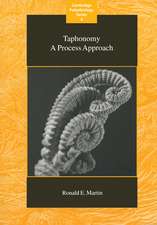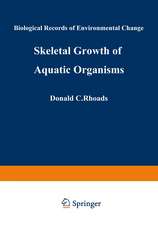Environmental Micropaleontology: The Application of Microfossils to Environmental Geology: Topics in Geobiology, cartea 15
Editat de Ronald E. Martinen Limba Engleză Paperback – 23 oct 2012
| Toate formatele și edițiile | Preț | Express |
|---|---|---|
| Paperback (2) | 826.48 lei 38-44 zile | |
| Springer Us – 31 iul 2000 | 826.48 lei 38-44 zile | |
| Springer Us – 23 oct 2012 | 1117.69 lei 6-8 săpt. |
Din seria Topics in Geobiology
- 18%
 Preț: 1858.10 lei
Preț: 1858.10 lei - 20%
 Preț: 822.08 lei
Preț: 822.08 lei - 15%
 Preț: 672.43 lei
Preț: 672.43 lei - 18%
 Preț: 1236.82 lei
Preț: 1236.82 lei - 15%
 Preț: 647.59 lei
Preț: 647.59 lei - 24%
 Preț: 885.02 lei
Preț: 885.02 lei - 18%
 Preț: 951.59 lei
Preț: 951.59 lei - 18%
 Preț: 964.23 lei
Preț: 964.23 lei - 15%
 Preț: 633.31 lei
Preț: 633.31 lei - 18%
 Preț: 966.27 lei
Preț: 966.27 lei - 18%
 Preț: 952.54 lei
Preț: 952.54 lei - 18%
 Preț: 949.85 lei
Preț: 949.85 lei - 18%
 Preț: 1013.50 lei
Preț: 1013.50 lei - 24%
 Preț: 821.17 lei
Preț: 821.17 lei - 18%
 Preț: 952.40 lei
Preț: 952.40 lei - 18%
 Preț: 961.23 lei
Preț: 961.23 lei - 18%
 Preț: 952.26 lei
Preț: 952.26 lei - 18%
 Preț: 960.42 lei
Preț: 960.42 lei - 18%
 Preț: 1843.11 lei
Preț: 1843.11 lei - 18%
 Preț: 954.31 lei
Preț: 954.31 lei - 18%
 Preț: 1256.41 lei
Preț: 1256.41 lei - 18%
 Preț: 959.50 lei
Preț: 959.50 lei - 15%
 Preț: 673.60 lei
Preț: 673.60 lei - 18%
 Preț: 954.14 lei
Preț: 954.14 lei - 15%
 Preț: 640.06 lei
Preț: 640.06 lei - 18%
 Preț: 959.36 lei
Preț: 959.36 lei
Preț: 1117.69 lei
Preț vechi: 1363.04 lei
-18% Nou
Puncte Express: 1677
Preț estimativ în valută:
213.86€ • 223.90$ • 176.96£
213.86€ • 223.90$ • 176.96£
Carte tipărită la comandă
Livrare economică 05-19 aprilie
Preluare comenzi: 021 569.72.76
Specificații
ISBN-13: 9781461368700
ISBN-10: 1461368707
Pagini: 504
Ilustrații: XVIII, 481 p.
Dimensiuni: 155 x 235 x 26 mm
Greutate: 0.7 kg
Ediția:2000
Editura: Springer Us
Colecția Springer
Seria Topics in Geobiology
Locul publicării:New York, NY, United States
ISBN-10: 1461368707
Pagini: 504
Ilustrații: XVIII, 481 p.
Dimensiuni: 155 x 235 x 26 mm
Greutate: 0.7 kg
Ediția:2000
Editura: Springer Us
Colecția Springer
Seria Topics in Geobiology
Locul publicării:New York, NY, United States
Public țintă
ResearchCuprins
I Baseline Studies of Foraminifera.- 1 When Does Environmental Variability Become Environmental Change? The Proxy Record of Benthic Foraminifera.- 2 Distribution Trends of Foraminiferal Assemblages in Paralic Environments: A Base for Using Foraminifera as Bioindicators.- II Water Quality in Modern Marine, Marginal Marine, and Freshwater Environments.- 3 Benthic Foraminifera as Bioindicators of Heavy Metal Pollution: A Case Study from the Goro Lagoon (Italy).- 4 Impact of Anthropogenic Environmental Change on Larger Foraminifera: Tarawa Atoll, Kiribati, South Pacific.- 5 Larger Foraminifera as Indicators of Coral-Reef Vitality.- 6 Ostracoda in Detection of Sewage Discharge on a Pacific Atoll.- 7 Ostracodes as Indicators of River Pollution in Northern Israel.- 8 Ostracoda as Indicators of Conditions and Dynamics of Water Ecosystems.- III Physiological Responses of Foraminifera to Pollution.- 9 Environmental Variation and Foraminiferal Test Abnormalities.- 10 Chemical Ecology of Foraminifera: Parameters of Health, Environmental Pathology, and Assessment of Environmental Quality.- IV Disturbance and Recovery Through Time.- 11 Use of Arcellacea (Thecamoebians) to Gauge Levels of Contamination and Remediation in Industrially Polluted Lakes.- 12 Sedimentary Diatoms and Chrysophytes as Indicators of Lakewater Quality in North America.- 13 Dinoflagellate Cysts as Indicators of Cultural Eutrophication and Industrial Pollution in Coastal Sediments.- 14 Environmental Stratigraphy: A Case Study Reconstructing Bottom Water Oxygen Conditions in Frierfjord, Norway, over the Past Five Centuries.- 15 Foraminifera of Storm-Generated Washover Fans: Implications for Determining Storm Frequency in Relation to Sediment Supply and Barrier Island Evolution, Folly Island, South Carolina.- 16 Benthic Foraminiferal Distributions in South Florida: Analogues to Historical Changes.- 17 Variation in Natural vs. Anthropogenic Eutrophication of Shelf Areas in Front of Major Rivers.- V Aquifers and Engineering.- 18 Establishing a Hydrostratigraphic Framework Using Palynology: An Example from the Savannah River Site, South Carolina.- 19 Construction of the Thames Barrier: An Application of Micropaleontology to the Solution of an Environmental Problem.










